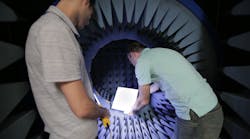Scientists Steer Radar Beams with Slight Change of Perspective
Updated on September 8th, 2016 at 1:40PM
The idea of metamaterials brings to mind comic book elements like Captain America’s vibranium shield or Wolverine’s adamantium claws. But metamaterials are not fictional. They are synthetic materials that bend things like radio waves in ways that don’t occur naturally.
One of the earliest applications for the technology is in radar systems. By applying voltages to an antenna built out of metamaterials, engineers can actively control the direction of the radar beam. That makes the radar system cheaper and smaller than ones steered by mechanical parts or other electronics.
But many engineers are not ready to stop using conventional materials to achieve similar results.
Last month, for example, scientists reported that they had built a new type of electronically-steered radar antenna. Writing in the Journal of Applied Physics, a team from the University of Wisconsin-Madison said that they had used a reflective antenna to bend radar beams in different directions.
The new technology brings together mechanical and electronic steering. A transmitter sends radio waves through an array of reflective antennas, which directs the radar beam depending on how the transmitter is tilted. The scientists are calling it a macro-electromechanical system (MÆMS) – a play on micro-electromechanical systems, or MEMS, which are widely used in sensors that react to tiny alterations in pressure or radio waves.
The team stressed that it will not use bulky mechanical rigs or specialized circuitry. “Our approach doesn’t depend on exotic materials that bend the laws of physics,” Nader Behdad, the electrical engineering professor who led the research, said in a news release.
“We’ve found a practical way to achieve beam steering that the antennas field has largely overlooked,” he added.
Radar systems locate and track objects by emitting radio waves and measuring the reflected signals. Some of the most advanced systems use electronics to direct radio waves without having to mechanically point the antenna in different directions. But these antennas normally use expensive and bulky electronics, known as phase shifters, to steer the radar beams.
The phase shifter’s bulkiness and cost have largely kept electronically-steered antennas out of commercial applications, like drones or automated driving systems. They are mostly reserved for defense applications, like fighter jets. Raytheon, for example, has developed an active electronically scanning array (AESA) system, which can track multiple objects, like ballistic missiles, at the same time. Lockheed Martin and Boeing are two other companies that make AESA radars.
What sets the MÆMS technology apart is that it doesn’t need solid-state devices or phase shifters integrated into the aperture of the antenna. The result, according to the scientists, is a radar system that can detect objects faster than mechanical radars used on airplanes and ships.
“In defense situations, you need to detect incoming objects where you are going very quickly,” said John Booske, another electrical engineering professor that worked on the project, which received $1.1 million in funding from the United States Office of Naval Research.
“The ability of a mechanical rig to move a big, heavy parabolic dish back and forth limits how quickly you can respond to potential threats,” Booske added
The new antenna works by focusing microwave signals through an array of reflective patch antennas. To focus the signal into a beam, it alters the electronic properties of the individual elements in the array. In addition, the individual elements can be tuned to act like a phase shifter and direct the radar beam.
The approach is similar to phase-varied array antennas, the team said. These systems are made up of miniature transmitters that each emit a fraction of a signal, which adds up to a single beam. By altering the electronic properties of each individual part, the antenna can steer the radio beam.
The MÆMS array is also built out of many individual elements. The difference, according to the scientists, is that it uses a single transmitter instead of many partial ones. There is a drawback to this design: it is more difficult to tune the antenna and shape the radar beam.
The scientists found the solution in the mechanical motion that they had originally tried to eliminate. They discovered that tilting the ground plane underneath the antenna array would tune all the elements simultaneously, directing the radar beam.
Though the MAEMS device is mechanical, the small tilting movement requires less time and force than turning a large reflector dish.
A prototype based on the research showed that slight tilts (around 0.05λ) in the ground plane could steer the beam +/- 10 degrees in two dimensions. Another prototype with the ground plane segmented into multiple parts was shown to steer beams +/- 30 degrees.
“Luckily for us, in order to do beam-steering, we really don’t need to individually tune each element,” said Behdad. “All we need to do is create a gradient and we can do that by simply tilting the ground plane.”

